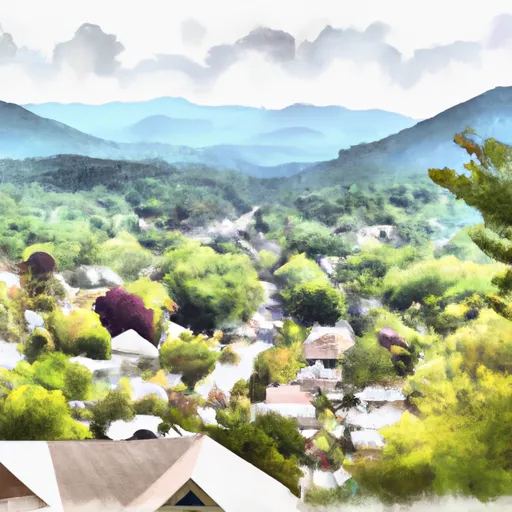-
 Snoflo Premium
Snoflo Premium
Get unlimited access to all our content
With no Ad interruptions! - Start Your Free Trial Login with existing account
Rabun-Gap
Eden Index
Climate
8.2
•
Recreation
9.6
•
Community
•
Safeguard
6.6/10

Rabun-Gap, Georgia is a small town located in the northeastern part of the state, nestled in the southern Appalachian Mountains. The climate in Rabun-Gap is generally mild, with warm summers and cool winters. The area experiences an abundance of rainfall throughout the year, contributing to the lush greenery and vibrant vegetation that surrounds the town.
Hydrologically, Rabun-Gap benefits from its proximity to numerous lakes, rivers, and streams. The town is situated near the Chattahoochee-Oconee National Forest, which encompasses several pristine bodies of water, including Lake Rabun and Tallulah Falls. These water sources not only provide scenic beauty but also offer various recreational opportunities, such as boating, fishing, and swimming.
Outdoor enthusiasts will find ample options for exploration and adventure in Rabun-Gap. The region is famous for its hiking and camping opportunities, with several well-maintained trails winding through the picturesque landscape. One of the highlights is the Tallulah Gorge State Park, which features breathtaking waterfalls and stunning views from its suspension bridge. Additionally, Rabun-Gap is a popular destination for birdwatching, with numerous species of migratory birds passing through the area.
In conclusion, Rabun-Gap, Georgia offers a pleasant climate, abundant water resources, and a range of outdoor recreational activities. It is an ideal destination for nature lovers and adventure seekers alike.
What is the Eden Index?
The Snoflo Eden Index serves as a comprehensive rating system for regions, evaluating their desirability through a holistic assessment of climate health, outdoor recreation opportunities, and natural disaster risk, acknowledging the profound impact of these factors on livability and well-being.
Climate Health Indicator (CHI): 8.2
Rabun-Gap receives approximately
1790mm of rain per year,
with humidity levels near 76%
and air temperatures averaging around
13°C.
Rabun-Gap has a plant hardyness factor of
7, meaning
plants and agriculture in this region tend to thrive during the non-winter months.
By considering the ideal temperature range, reliable water supplies, clean air, and stable seasonal rain or snowpacks, the Climate Health Indicator (CHI) underscores the significance of a healthy climate as the foundation for quality living.
A healthy climate is paramount for ensuring a high quality of life and livability in a region, fostering both physical well-being and environmental harmony. This can be characterized by ideal temperatures, reliable access to water supplies, clean air, and consistent seasonal rain or snowpacks.
Weather Forecast
Streamflow Conditions
Upper Tennessee
Area Rivers
Upper Tennessee
Snowpack Depths
Upper Tennessee
Reservoir Storage Capacity
Upper Tennessee
Groundwater Levels
Recreational Opportunity Index (ROI): 9.6
The Recreational Opportunity Index (ROI) recognizes the value of outdoor recreational options, such as parks, hiking trails, camping sites, and fishing spots, while acknowledging that climate plays a pivotal role in ensuring the comfort and consistency of these experiences.
Access to outdoor recreational opportunities, encompassing activities such as parks, hiking, camping, and fishing, is crucial for overall well-being, and the climate plays a pivotal role in enabling and enhancing these experiences, ensuring that individuals can engage in nature-based activities comfortably and consistently.
Camping Areas
| Campground | Campsites | Reservations | Toilets | Showers | Elevation |
|---|---|---|---|---|---|
| Old Salem | 120 | 550 ft | |||
| Lake Yonah County Park | None | 697 ft | |||
| Lake Russell | 42 | 1,081 ft | |||
| Oconee Springs County Park | None | 452 ft | |||
| Parks Ferry | 85 | 582 ft | |||
| Tallulah Gorge State Park | None | 1,551 ft | |||
| Hard Labor Creek State Park | None | 713 ft | |||
| Lake Sinclair | 61 | 335 ft | |||
| Oconee River | 5 | 561 ft | |||
| Toccoa Falls College RV Park | 12 | 870 ft |
Nearby Ski Areas
Catastrophe Safeguard Index (CSI):
The Catastrophe Safeguard Index (CSI) recognizes that natural disaster risk, encompassing floods, fires, hurricanes, and tornadoes, can drastically affect safety and the overall appeal of an area.
The level of natural disaster risk in a region significantly affects safety and the overall livability, with climate change amplifying these risks by potentially increasing the frequency and intensity of events like floods, fires, hurricanes, and tornadoes, thereby posing substantial challenges to community resilience and well-being.
Community Resilience Indicator (CRI):
The Community Resilience Indicator (CRI) recognizes that education, healthcare, and socioeconomics are crucial to the well-being of a region. The CRI acknowledges the profound impact of these elements on residents' overall quality of life. By evaluating educational resources, healthcare accessibility, and economic inclusivity, the index captures the essential aspects that contribute to a thriving community, fostering resident satisfaction, equity, and social cohesion.

